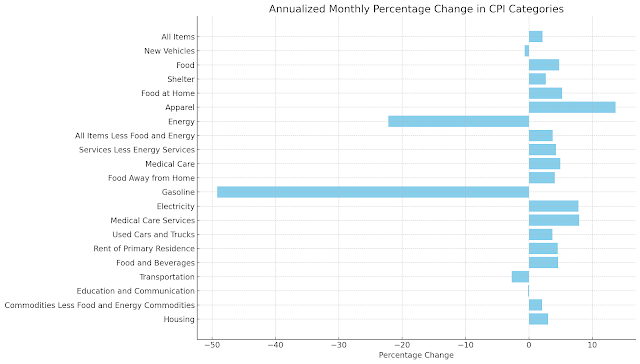The latest quarterly and annual percentage changes in key economic indicators provide valuable insights into the state of the U.S. economy. This analysis of personal consumption, private investment, government spending, exports, and imports paints a nuanced picture of growth areas and emerging concerns.
1. Steady Growth in Gross Domestic Product (GDP) and Personal Consumption
- Real GDP rose by 0.70% in the latest quarter and saw a 2.66% increase from the previous year. This steady growth aligns with broader economic recovery trends, showcasing a robust expansion across sectors, especially as consumers continue spending despite inflationary pressures and high interest rates.
- Personal Consumption Expenditures (PCE) reveal growth across all categories, driven especially by durable goods (up by 1.97% quarterly and 3.60% annually) as consumers invested in long-term assets. Nondurable goods and services also exhibited stable growth, though at more modest rates, suggesting consumer resilience in the face of evolving market dynamics.
2. Mixed Signals from Private Domestic Investment
- Overall private domestic investment showed a minor increase of 0.09% quarterly and a stronger 3.20% annual rise, suggesting moderate investment momentum.
- Fixed investment in nonresidential areas rose by 0.82% this quarter, with a solid 3.88% year-over-year gain, indicating that businesses are cautiously investing in expanding capacities and infrastructure. Meanwhile, residential investment experienced a 1.31% decline for the quarter, possibly reflecting high interest rates impacting home buying and construction investments.
3. Strong Export Growth Amid Global Demand
- The U.S. export sector experienced a notable uptick, with exports of goods and services growing by 2.16% quarterly and 4.46% annually, driven by increased global demand. Specifically, goods exports surged by 2.92% this quarter, suggesting strong foreign demand for U.S. products.
- Services exports also held steady, with an annual increase of 4.57%, reinforcing the U.S. economy's diverse export capabilities. The demand for services may stem from sectors such as travel, finance, and professional services as global economic activity recovers.
4. Imports Reflect Domestic Demand and Supply Chain Resilience
- Imports increased sharply, with goods and services imports growing by 2.69% quarterly and 7.25% annually. This trend hints at heightened domestic demand, underscored by a 2.79% increase in goods imports and an impressive 8.26% annual rise in service imports, possibly influenced by travel and related consumer activities.
- The growing import figures point to both robust domestic consumption and potential stockpiling as businesses prepare for future supply chain uncertainties. However, these rising imports could weigh on the trade balance, leading to trade deficits that impact economic growth rates.
5. Government Expenditures: Federal vs. State and Local Trends
- Government spending at the federal level, especially in national defense, grew significantly by 3.52% quarterly, with an annual increase of 4.14%, suggesting continued investment in defense capabilities amid shifting global dynamics.
- In contrast, state and local government expenditures grew more modestly at 0.58% quarterly, signaling a focus on maintaining essential services without aggressive spending increases. State and local expenditures likely reflect the fiscal constraints and cautious budgeting amidst economic uncertainties.
Concluding Thoughts
These trends suggest that the U.S. economy is adapting, with a combination of steady growth in consumer spending, cautious business investment, and robust trade activities. However, the decline in residential investment and significant import increases reflect the lingering effects of high interest rates and ongoing supply chain adjustments. The data underscores the importance of navigating these complexities with careful monetary policies to sustain balanced growth.
Overall, the U.S. economy is expanding steadily, but certain sectors remain sensitive to interest rates and global demand fluctuations. Monitoring these indicators in the coming quarters will help anticipate shifts in the broader economic landscape.


.png)


.png)
.png)
.png)
.png)



.png)




